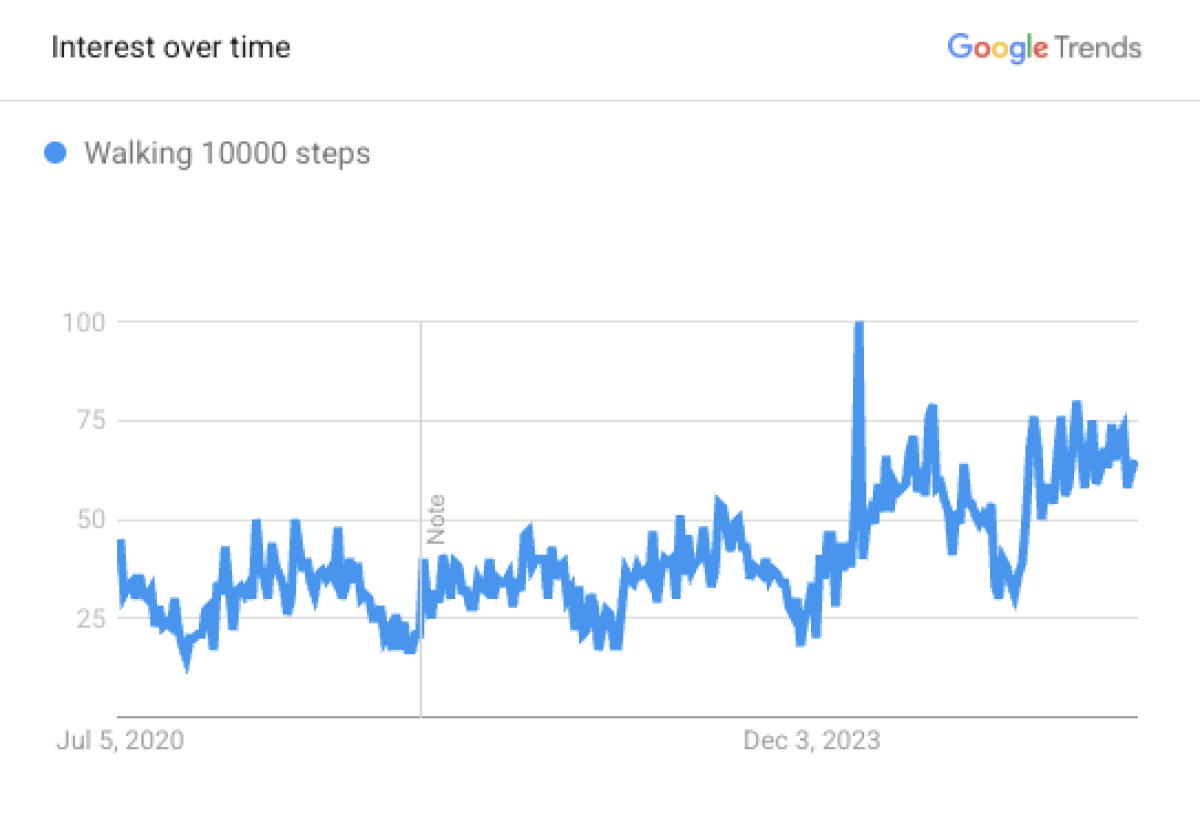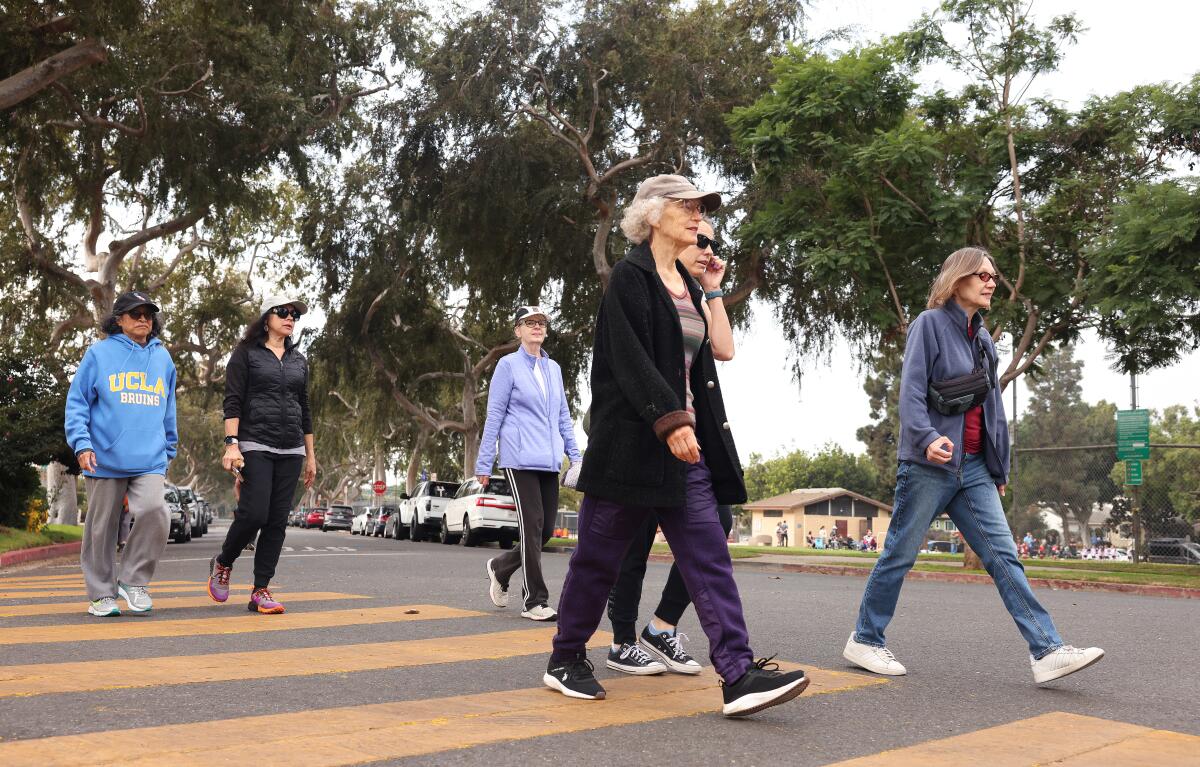The magic quantity reveals up on smartwatches, health apps and workplace step challenges. For a lot of, hitting 10,000 steps in a day has change into a marker of excellent well being — a objective that prompts post-dinner walks, lunchtime laps across the block and a purpose to park a little bit farther away.
Whereas the goal is broadly embraced by medical doctors and their sufferers, its origins are much less scientific than some could count on.
“The whole idea behind the 10,000 steps was actually a marketing campaign for a company in Japan that developed a pedometer,” stated David Raichlen, professor of organic sciences and anthropology at USC.
The concept of strolling 10,000 steps a day gained recognition in Japan within the Nineteen Sixties, when an organization launched a pedometer referred to as the Manpo-kei — a reputation that interprets to “10,000 step meter.” Launched across the time of the 1964 Tokyo Olympics, the product gave folks a numerical objective and helped promote pedometers.
“It was kind of brilliant,” Raichlen stated. “Is it arbitrary? Yes.”
A pair benefit from nice climate to stroll their canine within the Venice Canal Historic District in Venice Seashore.
(Allen J. Schaben / Los Angeles Instances)
Researchers say that even when the quantity wasn’t evidence-based on the time, it caught on for a purpose — and should have landed near a significant benchmark.
“It turns out, bizarrely enough, they probably weren’t that far off, even though they did not have any of the epidemiological data to support it at the time,” Raichlen stated.
Within the years for the reason that 10,000 step goal gained attraction, researchers have tried to pinpoint what number of every day steps are literally linked to raised well being outcomes. Some research present that advantages corresponding to decreased danger of heart problems start round 2,500 to three,000 steps a day. Others counsel a plateau of health-related advantages begins round 7,500 steps, Raichlen stated.
Nonetheless, many public well being messages proceed to advertise the five-digit mark, and health trackers, together with Fitbits and different sensible gadgets, typically set 10,000 steps because the default every day objective.
Dr. Gregg C. Fonarow, interim chief of cardiology at UCLA, stated step counts are a sensible, easy-to-understand approach to talk bodily exercise pointers with sufferers. He typically recommends 10,000 steps and doesn’t view the quantity as random.
“Conveying step count is one of the ways of quantifying, easily and understandably, a trackable, actionable way to communicate what would be a good level of physical activity for them,” Fonarow stated.

Searches for “walking 10000 steps” have elevated over the previous 5 years.
(Google Developments)
He stated 10,000 steps equals roughly 5 miles of strolling and about 150 minutes of moderate-to-intense exercise — in keeping with present pointers for weekly train.
Nonetheless, Fonarow acknowledges that analysis findings differ. He cites one research that discovered danger discount plateaued round 7,500 steps for older girls, whereas different research have discovered profit persevering with by way of 10,000 steps or extra. “Walking is a fantastic form of exercise,” Fonarow stated. “It improves blood pressure, supports brain health, reduces insulin resistance and helps strengthen the blood vessels.”
Raichlen stated he sometimes avoids prescribing particular thresholds. Whereas 10,000 steps could also be a helpful objective for some, he stated, it isn’t a requirement for good well being.
“A little bit is better than nothing, and then a little bit more is better than that,” Raichlen stated.
Nevertheless, the kind of strolling issues. Researchers have discovered that cadence — what number of steps an individual takes per minute — can affect the impression of bodily exercise. A brisk stroll gives higher cardiovascular profit than a slower tempo even with the identical whole step rely.

Wes Brumbaugh, left, and Tucker O’Neill get in some steps on their 41-mile stroll throughout Los Angeles. In 2023, they went from Pasadena to Santa Monica.
(Irfan Khan / Los Angeles Instances)
“You don’t have to run,” Raichlen stated. “But more intensity is generally better.”
What’s not clear, he stated, is whether or not there’s an higher restrict the place advantages start to say no — or if extra steps at all times yield extra return.
He stated strolling extra is mostly tied to decrease danger of a number of continual circumstances, together with diabetes, dementia and heart problems, however the danger discount plateaus after a sure level.
“The health outcome you are interested in — whether that be heart disease, diabetes, dementia — there are different steps recommended,” he added.
Raichlen additionally identified that the effectiveness of a given step rely could differ by age and that the majority present research depend on wrist-worn accelerometers, which may differ in precision.
“You can use multiple methods and end up with multiple different step counts from the exact same person,” Raichlen stated, including that his sister-in-law and her son tracked their steps on a current journey to Disneyland utilizing completely different gadgets — one with a telephone, the opposite with an Apple Watch — and got here away with very completely different totals.
That variation, he stated, reinforces the significance of utilizing step counts as a information moderately than a inflexible rule.
“The best thing people can do is to be their own study,” Raichlen stated. “Look at what you’re doing today and try to do more tomorrow.”
Fonarow stated he typically encourages sufferers to construct exercise progressively. For many who are largely sedentary, attempting to stroll 10,000 steps on day one will not be sensible. “We really need to personalize these recommendations,” he stated, including that some folks could select so as to add resistance — like a weighted backpack — for added advantages, nevertheless it’s not crucial for improved well being.

The Culver Metropolis EverWalk Strolling Membership, one in all a number of strolling teams in L.A., normally meets on the primary Saturday of each month.
(Christina Home / Los Angeles Instances)
Dr. Parveen Garg of Keck Medication of USC additionally sees sufferers aiming to fulfill step targets. Whereas spreading exercise all through the week is right, he stated it’s high-quality if some days are extra energetic than others. For sufferers with restricted time or power, strolling extra on the weekends or throughout longer breaks can nonetheless supply significant advantages.
Garg stated he reminds sufferers that strolling is helpful even at decrease ranges. A number of research present that danger of heart problems and untimely loss of life decreases measurably starting round 2,500 steps per day, he stated.
Whereas spreading exercise all through the week is right, he stated it’s high-quality if some days are extra energetic than others. For sufferers with restricted time or power, strolling extra on the weekends or throughout longer breaks can nonetheless supply significant advantages. Like different consultants, Garg emphasizes that the advantages of motion don’t start at 10,000 steps — they will begin a lot earlier.
“As humans, we like goals,” Garg stated. “We like to feel like we’ve accomplished something. We like to check off boxes. … It does give people a goal to accomplish. In that aspect, it’s really great — as long as it does not discourage people.”
He encourages his sufferers to prioritize cardio exercise — motion that will get the guts charge up — even when it’s finished in brief bursts or blended into every day routines.
Whether or not an individual walks 2,000 steps or 10,000, native consultants agree the secret’s consistency, and growing exercise over time might be useful.
“Just keep moving,” Raichlen stated.


